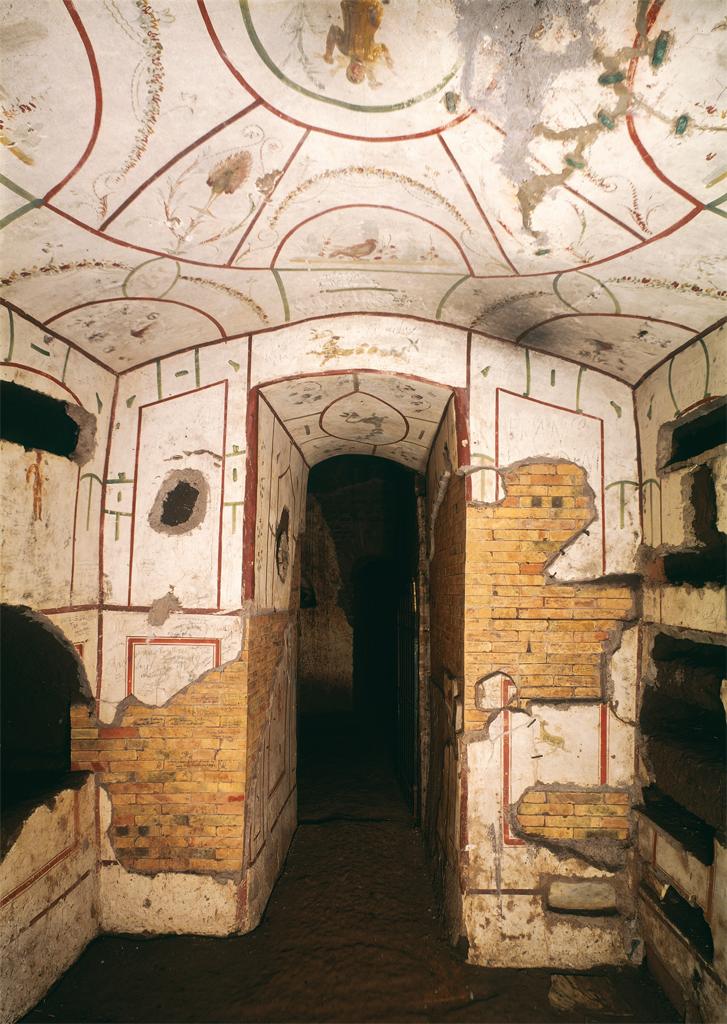Catacombs of Rome Open for Fall Tours
In our collective imagination the Catacombs of Rome have always been considered, somewhat erroneously, as the secret hideout of early Christians during a time of persecution. In fact during the early centuries of Christianity, the Romans, until then the conquerors of an immense realm whose borders extended from the Middle East to Britain, were too busy defending the collapsing empire to notice cities of the dead growing beneath their feet.
Though on rare occasions they were used as places to officiate Christian liturgy in privacy, in fact the catacombs began around the First Century as no more than simple underground cemeteries. Underground burial was not exclusive to Christians, however, and, as the larger regional culture shifted from cremation to inhumation as an entombment ritual, this practice was also very popular among both pagans and the Jewish communities then present in Rome.
During September and October, the International Catacomb Society offers visitors the opportunity to join small groups to tour some of these sites, including the catacombs of Generosa, Pretestato, Vigna Randanini and ad Decimum. Most of the guided walks are free or charge a nominal fee, but reservations are required (check the Society’s website for specific dates and fees) .
Approximately 35 catacombs are known within Rome, ranging in size from a single burial chamber (cubiculum) for the use of one family to vast multi-level networks of underground passages and cubiculae. One of the oldest and largest catacombs is that of St. Callisto (Callixtus) on the Via Appia Antica.
By the end of the Middle Ages all but a few of the underground cemeteries had been abandoned and forgotten. Interest in early Christian rituals was revived during the Counter-Reformation, resulting in the first attempts, by such antiquarians as Antonio Bosio (1576-1629), to rediscover the catacombs and record their decorations, though systematic exploration and study began only in the mid-19th century under Giovanni Battista de Rossi (1822-1894). This work has continued under the auspices of the Pontificia Commissione di Archeologia Sacra.
Reference: John Osborne. “Catacombs.” Grove Art Online. Oxford art Online. Oxford University Press, 2016.
Detail from the Randanini Vigna Catacomb, Tomb of the Roccagiovine Gallo family, c. 500, Rome. Photo: International Catacomb Society.
Loculi and Arcoslium, Catacomb of Priscilla, Rome, c. 250. Photo: Scala Archives.
Catacomb of Domitilla, Cubiculum of the Good Shepherd, c. 300, Via Ardeatina, Rome. Photo: Scala Archives.
Entrance to the Tomb of Callisto (Callixtus), Rome. Photo: Wikimedia Commons.
Tombstone with inscription in Greek, with menorahs, c. 100-300, Jewish catacomb of Monteverde, Rome, Photo: Erich Lessing / Art Resource, New York City.
Catacomb of Callisto (Callixtus), Crypt of Lucina, detail of fish and Eucharist, c. 250, Rome. Photo: University of California at San Diego.
Further Reading:
Gregory S. Athnos. The Art of the Roman Catacombs: Themes of Deliverance in the Age of Persecution. Denver: Outskirts Press, 2011.
Paul Koudounaris, Heavenly Bodies: Cult Treasures and Spectacular Saints from the Catacombs. New York City: Thames & Hudson, 2013.
Posted by Jean Marie Carey





